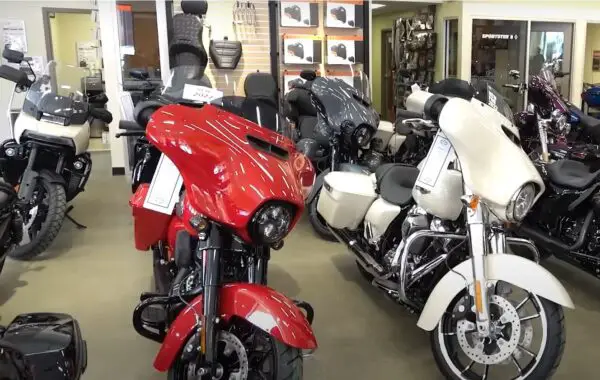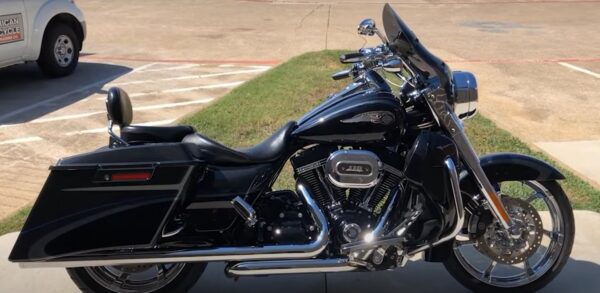Choosing one from Honda Navi and Monkey is easier because these two bikes are so different.
But still, if you are confused between these two bikes and cannot figure out which will be the best option for you, don’t worry.
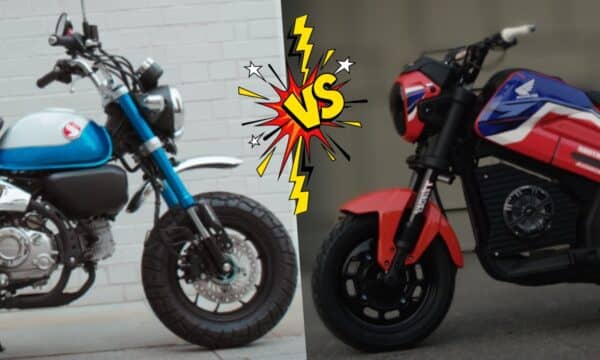
Because we have to work harder to test and make clear differences to choose the best. Although it’s up to your preferences what things you need from your bike.
Let’s dive into the adventure:
Honda Navi Vs Monkey
There are many new and advanced features in the Honda Monkey to choose from first, but if you need something under budget, you should go with the Honda Navi. Because it is much cheaper as compared to Monkey.
Differences Between Honda Navi and Honda Monkey
We will look at the main differences between these bikes and then glance at them individually. So that we will be able to make a correct decision to choose one best for yourself.
Related: Honda Navi Vs Honda Grom

Here is a comparison table that will help you to see the clear difference in every single feature of the Honda Navi and Honda Monkey.
| Feature/Specification | Honda Navi | Honda Monkey |
| Engine Type | Single-cylinder, 4-stroke | Single-cylinder, 4-stroke |
| Displacement | Approx. 109.2 cc | Approx. 124.9 cc |
| Power | Approx. 7.9 HP | Approx. 9.25 HP |
| Torque | Approx. 8.79 Nm | Approx. 11 Nm |
| Transmission | V-matic | 4-speed / 5-speed |
| Fuel System | PGM-FI | PGM-FI |
| Starter | Electric | Electric |
| Front Brake | Drum | Disc |
| Rear Brake | Drum | Disc |
| Fuel Tank Capacity | Approx. 3.8 liters | Approx. 5.6 liters |
| Kerb Weight | Approx. 101 kg | Approx. 105 kg |
| Tires | Tubeless | Tube-type |
| Front Suspension | Telescopic | USD forks |
| Rear Suspension | Spring-loaded hydraulic | Twin shock absorbers |
| Seat Height | Approx. 765 mm | Approx. 776 mm |
| Length | Approx. 1805 mm | Approx. 1710 mm |
| Width | Approx. 748 mm | Approx. 755 mm |
| Height | Approx. 1039 mm | Approx. 1030 mm |
| Wheelbase | Approx. 1286 mm | Approx. 1155 mm |
| Ground Clearance | Approx. 156 mm | Approx. 160 mm |
| Price | $1,800-$1,900 | $4,200-$4,300 |
Pros and Cons Honda Navi
Pros
- More than 6 Colours are available
- 109 cc engine
- Single cylinder, 4 Stoke engine
- Electric starter and Kik backup
- Fully automatic CVT transmission
- Affordable
Cons
- No ABS include
- Drum Brakes
- Small fuel tank
Pros and Cons Honda Monkey
Pros
- 125 cc engine
- Air-cooled single-cylinder four-stroke engine
- ABS Brakes
- Electric starter
- Five Speed transmission
- Inverted Forks
- Huge tank capacity
Cons
- Only 3 Colour Options
- Much expensive
1. Design & Style
Honda Navi was introduced for the Indian market and designed to blend the convenience of a scooter with the appeal of a motorcycle.
The Honda Activa, a popular scooter in India, inspired its underbone frame design.
It is minimalistic with a compact and straightforward design. It looks like a smaller, stripped-down bike. It has telescopic front forks and a hydraulic shock at the rear, akin.
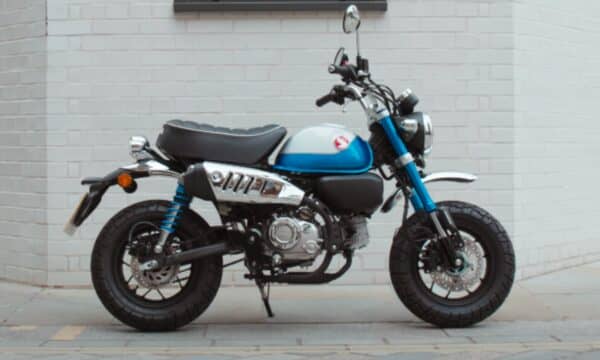
Navi comes with very minimal bodywork without any flashy elements. The flat and elongated seat offers comfortable seating for the rider and passenger. It provides standard handlebars, which gives it a more motorcycle-ish look than a scooter.
Navi is relatively minor, lightweight, and more suited for crowded city traffic.
When we look at the Honda Monkey features a compact steel frame that gives it a sturdy yet diminutive stance. Retro and iconic, it pays homage to the original Monkey bikes of the 60s and 70s with its design elements. Upside-down front forks and twin rear shocks give it a more genuine motorbike feel.
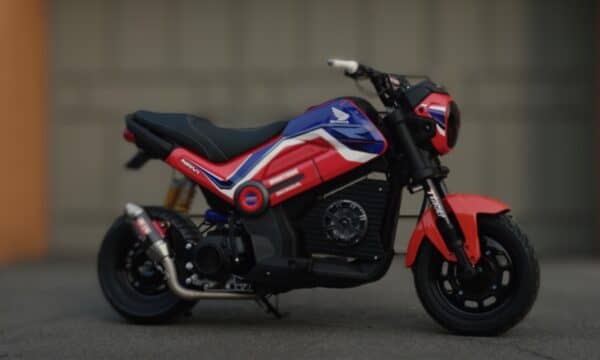
Regarding style, it offers chrome and vibrant colour finishes that give it a vintage appeal. Seats are cushioned, with a classic appearance, positioned relatively lower, accommodating riders of various heights. It’s slightly bigger and heavier than the original Monkey bikes, making it more suited for adults.
2. Engine & Performance
The Honda Navi features a 109.19 cc, single-cylinder, air-cooled, 4-stroke engine. It is the same engine that powers the Honda Activa, one of the best-selling scooters in India.
But on the other hand, Monkey comes equipped with a 124 cc, single-cylinder, air-cooled, 4-stroke engine. It has a slightly larger displacement than the Navi.
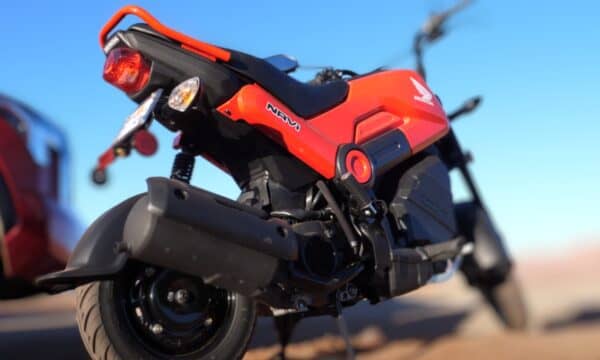
Let’s talk about the torque of the engine. Navi’s engine produces around 8 bhp (brake horsepower) at 7,000 rpm. It also provides 8.96 Nm of torque at 5,500 rpm. While the Monkey has a slight edge due to its larger engine.
It also has a higher torque, which means better acceleration and pulling power. The motor on the Monkey delivers around 9.25 bhp at 6,750 rpm and 11 Nm of torque at 5,250 rpm.
On comparing the performance of these bikes, Navi offers agile handling in urban environments. It’s not built for high-speed cruises, but its low-end torque provides ample pep for city commutes.
The Monkey offers a playful riding experience due to its retro design inspired by the original Monkey bike of the 1960s. Its slightly larger engine provides more power than the Navi, making it zippier.
When we test both engines’ fuel efficiency, the Honda Navi gives an advantage due to its decent fuel efficiency, usually hovering around 50-60 km/l depending on various conditions.

On the other hand, Honda Monkey generally has a fuel efficiency range of 45-55 km/l, varying with conditions.
3. Transmission
The Honda Navi uses a V-matic automatic transmission widely used in many scooters. The Honda Monkey features a 4-speed manual transmission, which is now upgraded in the newer models to a 5-speed transmission.
The V-matic transmission provides the Navi a smooth ride, free of needing to shift gears manually. Manual transmissions in Monkey offer more control over the engine’s power output, allowing for precise gear selection based on the riding conditions.
It is beneficial when rapid acceleration or engine braking is needed. Honda Navi is beginner-friendly due to its automatic transmission.
No clutch operation or manual gear changes are required, making it accessible for riders of all skill levels. On the other hand, in the case of Monkey, manual transmissions require more skill to operate.
You must coordinate clutch operation with gear shifts, and there’s a learning curve for those new to manual transmissions.
4. Handling
Honda Navi is more in line with scooters than traditional motorcycles, which makes it incredibly easy to use in city traffic and park in tight spaces.
On the other hand, being a mini-bike, the Monkey is short, and squat is easy to handle, particularly at low speeds. Despite its small size, the Monkey has a stable ride due to its wide tires.
The Navi offers a reasonably smooth ride over urban terrains due to its front telescopic suspension and rear hydraulic type. However, the Navi will not provide the best absorption on rough surfaces.
The Monkey is easy to handle both city rides and slight off-road terrains. It provides a cushioned experience due to its upside-down fork in the front and twin rear shock absorbers.
Due to their thin tires, the Navi tyres grip well on dry roads but will inspire less confidence in wet conditions. It also offers decent stopping power suitable for its design and purpose.
The Monkey provides better grip and stability on dry and wet surfaces due to wider tires. It gives a reassuring braking performance due to its disc brakes at the front and rear.
Its 110cc engine makes the Navi nimble and agile, especially in city traffic. Its lightness ensures that swerving and changing lanes is a breeze.
While a slightly bigger engine powers Monkey, it isn’t just about nostalgia; it has enough punch to navigate urban landscapes.
Its wide tires and sturdy build give it a slight edge regarding stability during manoeuvres.
5. Price
On comparing the price range of both bikes, there is a clear difference between the Honda Navi and the Honda Monkey.
Navi is a smaller and less powerful bike launched for the Indian market; its price ranges from $1800 to $1900, which is quite affordable.
But when we see the Honda Monkey, it is more powerful and comes with new features, which may cost you almost $4200 to $4300.
The best option for you could be the Navi if you seek a budget-friendly bike.
But if you want a motorcycle that looks more like a scooter, Monkey is the best option. Of course, you must invest more money to get extraordinary features.
Final Thoughts: Which is the Best?
The Honda Navi and Honda Monkey represent Honda’s commitment to producing fun, efficient, compact two-wheelers. However, they cater to different audiences and have distinct characteristics that set them apart.
The Honda Monkey is an iconic mini-bike, evoking nostalgia with its retro design while incorporating modern technology. It’s a perfect blend of old-school charm and new-school functionality.
It is ideal for enthusiasts looking for a bike with character and history. Its slightly higher price can be justified by its unique design, build quality, and many riders’ emotional connection towards it.
On the other hand, the Honda Navi is a fresh take on urban commuting, blending a scooter’s simplicity with a motorcycle’s appeal. The affordability, easy handling, and innovative design make it an attractive option for city dwellers and young riders.
It’s a practical choice for daily commuting, offering decent storage space and efficient fuel consumption.
Whichever you choose, both bikes offer the reliability and quality one expects from Honda, which ensures that you have invested in a product that will serve you well for years.
Sources:
You may love to read!

Ahtsham Younas is a passionate blogger and content writer. He loves to ride motorcycles and learn the mechanical process behind the motorcycles.
He has been writing articles in the motorcycle industry since 2019 and has learned many things about motorbike niches.

